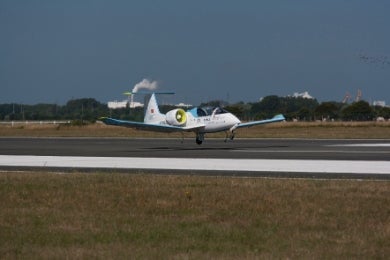

Lockheed Martin agrees to buy Sikorsky for $9bn

Lockheed Martin agreed to acquire United Technologies’ helicopter-producing subsidiary Sikorsky Aircraft for $9bn.
The acquisition is expected to strengthen Lockheed Martin’s presence in aerospace and defence products, and the technologies segment.
Following the deal, Lockheed will become one of the major helicopter producers in the military and commercial rotorcraft market.
The company plans to operate Sikorsky under its Mission Systems and Training (MST) business segment.
GKN to acquire Netherlands-based Fokker Technologies for €706m
UK-based GKN signed a deal to acquire Netherlands-based Fokker Technologies from Arle Capital for €706m, in order to strengthen its presence in the aerospace industry.
How well do you really know your competitors?
Access the most comprehensive Company Profiles on the market, powered by GlobalData. Save hours of research. Gain competitive edge.

Thank you!
Your download email will arrive shortly
Not ready to buy yet? Download a free sample
We are confident about the unique quality of our Company Profiles. However, we want you to make the most beneficial decision for your business, so we offer a free sample that you can download by submitting the below form
By GlobalDataFokker is a Tier 1 supplier to commercial, military, and business jet segments, including lightweight aero-structures, electrical wiring interconnection systems and landing gear.
The company also provides maintenance, modification and logistic services to aircraft owners and operators, and has a workforce of around 5,000 with operations in Europe, North America and Asia.
Solar Impulse 2 round-the-world flight postponed over battery damage

Zero-fuel Solar Impulse 2 (SI2) halted its round-the-world flight until early April 2016 over a major failure of its batteries due to overheating.
Earlier this month, the solar-powered aircraft completed its eighth stage trip from Nagoya, Japan, to Hawaii, US.
During the record 117h and 52min flight, the SI2 batteries overheated due to a high-climb rate and an over-insulation of the compartment.
Solvay to acquire US-based Cytec for $5.5bn
Belgian firm Solvay signed a deal to acquire US-based Cytec for $5.5bn, to exploit the demand for lightweight composite materials in the aerospace industry.
Cytec is engaged in the production of composite materials and mining chemicals.
Its composite materials operations represent two thirds of the company’s sales, providing primary and secondary structures for aircraft.
Swiss engineers develop space junk clean-up satellite

Engineers from eSpace, Swiss Federal Institute of Technology in Lausanne (EPFL), and the University of Applied Sciences and Arts of Western Switzerland (HES-SO) completed the prototype stage of the Clean Space One (CSO) project, aimed to develop technologies to clear space debris.
The team finalised critical decisions associated with the development of the approach and capture systems.
Scientists are working towards sending a space clean-up satellite into orbit to capture the SwissCube satellite, which has been in Earth orbit for more than five years, and destroy it in the atmosphere.
Airbus E-Fan completes longest-ever electric flight

Airbus completed the longest-ever flight of its electrically powered E-Fan aircraft, which traversed the English Channel.
During the 36min flight, the aircraft travelled 74km between Lydd, England, and Calais in France.
Flown by test pilot Didier Esteyne, the lithium-ion battery-powered E-Fan reached a maximum altitude of around 1,000m. It weighs approximately 600kg.
The aircraft is equipped with two 32kW electric motors, and is designed to cruise at around 100mph for up to an hour. It features a parachute that can be deployed in case of an unexpected failure.
Fraunhofer researchers developing space debris surveillance system
Researchers from Fraunhofer Society of Germany are developing a space surveillance system that will help tackle potential collisions of satellites and spacecraft with space debris in low-Earth orbit.
The tracking radar being developed for DLR Space Administration is scheduled to go into operation in 2018.
DLR awarded a contract to the Fraunhofer Institute for High Frequency Physics and Radar Techniques FHR to develop the radar system.
UK scientists trial bomb-proof lining to tackle aircraft explosions

A team of scientists, including some from the University of Sheffield, trialled a bomb-proof lining technology on an aircraft at Cotswolds Airport in the UK.
Named Fly-Bag, the bomb-proof lining was evaluated through a series of controlled explosions in the luggage hold of unused aircraft, near Cirencester.
Fly-Bag lines an aircraft luggage hold with multiple layers of fabrics and composites to manage the impact of bomb blasts.
Purdue University develops aircraft engine cooling technology

Purdue University researchers developed a heat exchange device to help supersonic aircraft engines stay cool.
The system features a heat exchanger that comprises various modules, where cold fuel is passed through internal mini-channels and hot air is passed in cross-flow along the finned outer surface.
The device is claimed to minimise weight and volume, while increasing heat transfer of the engine. Its modules can be configured to suit the engine package requirements.
Usually, hot engine components are cooled by air from the engine’s compressor; however such system would not be able to tackle the scenario in high-performance engines.
Stephen Hawking backs venture to seek out extraterrestrial life
Russian Internet entrepreneur Yuri Milner and physicist Stephen Hawking partnered to launch a $100m initiative to search for extraterrestrial life in the universe.
Called Breakthrough Initiatives, the venture will scan signals from one million closest stars, galactic planes of the Milky Way, and messages from the 100 closest galaxies to Earth.
Astronomers will focus on two aspects, Breakthrough Listen and Breakthrough Message.


